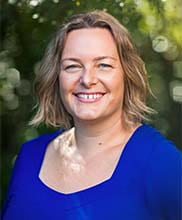Dr Sophie Pearson-Grant

Dr Sophie Pearson-Grant is a senior geothermal geophysicist at GNS Science. Her expertise lies at the interface of earth sciences and numerical modelling. She joined the geothermal group at GNS in 2010 after completing a Presidential Doctoral Fellowship at University of South Florida, USA and an undergraduate masters at Leeds University, UK. During her studies, she collected geophysical measurements on 4 continents and at 11 active volcanoes. Modelling this data led to a focus on the complex pathways that fluids take from the heat source to the surface, which has been her specialty ever since. Her work has won awards at 3 international conferences, received a prestigious Marsden Fast-Start grant, and been featured on radio and in the NZ Herald, US GeoHeat bulletin, and Wilderness magazine.
Sophie has a passion for protecting the environment, and the fundamental role that geothermal energy can play in reducing fossil fuel use and powering communities.
Abstract
Fluid flow at different scales in the geothermal fields of New Zealand
Sophie Pearson-Grant, Ted Bertrand, Warwick Kissling, Craig Miller, Samantha Alcaraz, Lucy Carson, Penny Doorman, Cornel de Ronde, Sarah Milicich, John Burnell
New Zealand is blessed with a range of geothermal resources in some very complex geological settings. Geothermal fluid flow results from the interaction of water with heat sources, permeable pathways, and topographic influences. A lot of work has gone into understanding fluid flow in individual geothermal fields for production, but what can we learn about fluid flow processes when we don’t have much well data? Or when we want to understand fluid circulation on a larger scale? New insights can be gained by merging increasingly extensive geophysical and geological surveys of the central North Island of New Zealand into numerical flow models. I will present examples from four very different settings: Tauranga low-temperature geothermal system, the pre-1886 eruption Pink and White Terraces hydrothermal systems at Lake Rotomahana, the Okataina Volcanic Centre, and the wider Taupo Volcanic Zone. Simplified fluid and heat flow models show that there is no one dominant process, and that there are still many open questions around the locations, natural lifecycles, and sustainability of geothermal systems. Combining regional-scale research with the geothermal industry’s collective knowledge, we can start to answer these questions and thereby work out ways to sustainably manage these diverse systems and get more geothermal energy to the grid, industries, and our communities.

